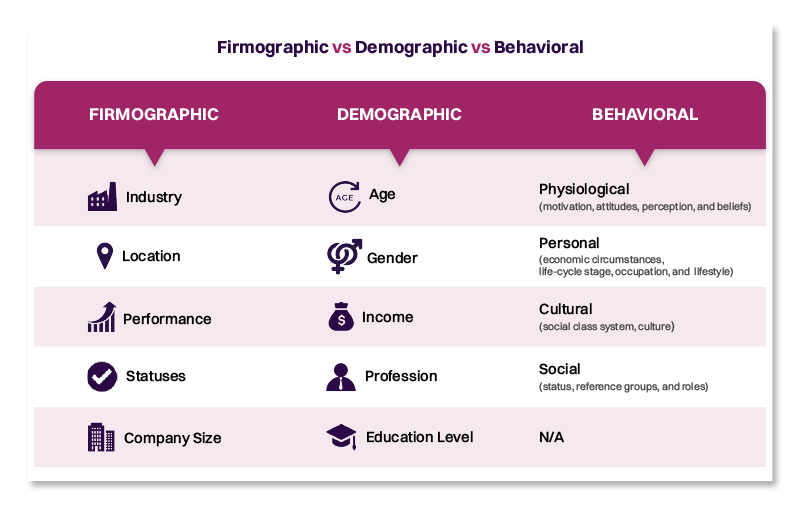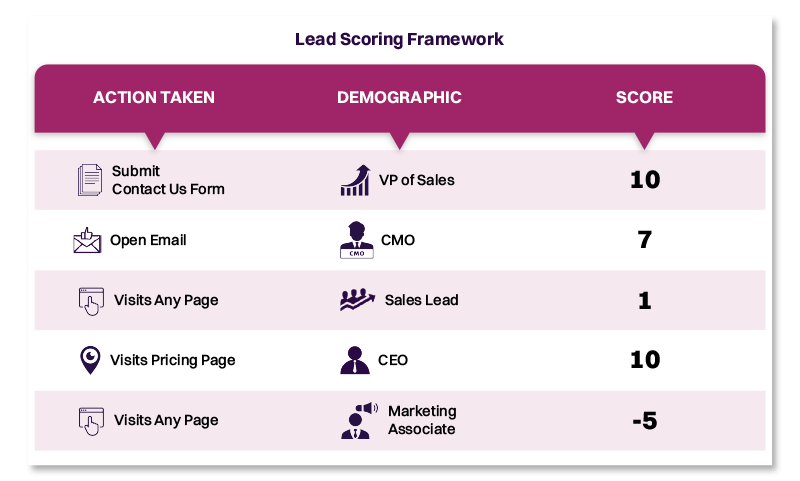
The Best MQLs Guide For The SDRs To Increase Sales Opportunities
Marketing Qualified Leads (MQLs) are more likely to be your paying customers. Thus, prioritizing MQLs will boost your sales efficiency and improve conversion rates. However, that depends on how your marketing team handles them. They're the ones who look for MQLs' further engagement and nurturing.
Therefore, your marketing team must know about MQLs deeply, such as their characteristics, the best time to approach them, and how to handle them.
So that they can smoothly hand off these leads to Sales Development Representatives (SDRs).
The article shares a detailed MQL guide for the SDRs to help them push MQLs further in the sales funnel.
MQLs Criteria And Characteristics To Know
What does MQL stand for? Leads are categorized into MQLs when they:
1. Show A High Interest In The Product Or Service
MQLs may perform the following actions to show their interest in your product/service:
- Download content like white papers or ebooks from your company's website.
- Sign up for a newsletter or subscribe to your company's blog.
- Fill out a form on the company's website to book an appointment or request more product/service information.
- Participate in your company's webinar programs or attend trade shows where the company’s reps are present.
- Interact with the company's social media channels. It includes liking or sharing posts related to the product or service.
SDRs need to track and score these actions to identify high-value MQLs.
2. Have Alignment With The Target Market
Set MQL criteria to ensure leads align with your company's ideal customer profile/target market. The customer profile combines targeted demographic, firmographic, and behavioral characteristics of prospects. These include elements such as:

Among these, focus primarily on the following elements while picking leads that align with your ICP:
- Industry: The lead works in an industry that fits your company's products or services.
- Company size: The lead's company size falls within your target employee count or revenue range.
- Income: The lead is capable of spending expenses as per the budget you offer for your service/product.
- Role: They hold a position that allows them to understand the benefits of your company's offerings. They may be decision-makers or influencers.
- Geographic location: The lead lives in a region where the company has existing business or plans to expand.
- Belief/value: Your target lead shares similar business values and beliefs as yours. These leads make the best B2B partnerships.
3. Qualify To Enter Lead Scoring Framework
68% of highly efficient and effective businesses consider lead scoring as their top revenue contributor.
Thus, creating lead scoring criteria is a must for sales success. However, not all leads should enter your lead scoring system. It will only increase the unnecessary crowd. Similarly, you must add only high-value MQLs to your lead-scoring framework to avoid wastage of resources.
An MQL can enter your lead scoring framework when they:
- Often visit and spend considerable time browsing the company's website.
- Fill out a contact form, providing information about their needs and interest in the company's offerings.
- Score a certain number of points based on their behavior. It includes attending a product demo or clicking on a follow-up email. It comes under implicit criteria.
- Pass explicit criteria (belonging to your target job title, budget, company size, geographic location, and industry.)
- Acquire a high threshold score based on their past behavior and sales data.
Let’s take an example and distribute the leads as per the designation of a B2B organization that fits your ICP. Once the leads fulfill the criteria to enter the lead scoring framework, you can distribute scores (from 1-10) in the following manner. You can score negatively if the demographic information doesn’t fit to your criteria.

Sales Development Engagement with MQLs: Appropriate Timing And Condition
Consider the following factors in determining when your sales development team should engage with MQLs:
- Lead Scoring: Analyze the lead score you give each MQL by considering their value in the funnel. It helps to identify when an MQL is ready to be passed to the SDRs for further engagement.
- Customer Journey: Consider where the MQL is in its customer journey. Plus, what actions did they take?
For example, if an MQL downloads a whitepaper or attends webinars, it is a good sign for the SDRs to focus on converting them. - Sales Capacity: Assigned SDRs should be ready to handle the leads passed to them. They should have information about the lead’s unique needs, expectations, and possible objections.
MQL Guide For The SDRs: How To Handle Them
Step 1: SDRs must use personalized email, text messaging, direct mail, or other outreach tactics to engage with the leads. Make them aware of the product/service and how they can benefit from it. The goal is to move them further down the sales funnel.
Additionally, consider sending emails to leads between 8:00 AM to 3:00 PM. People are more likely to check their emails at this specific duration.
Step 2: Your SDRs should begin with follow-ups to determine the lead’s interest level. They can use follow-up tactics like phone calls, email messaging, etc.
Consider the following tips to approach MQLs via follow-up phone calls:- Choose Wednesday and Thursday for follow-up calls over other weekdays. Stats say there’s a 68% and 56.5% chance people will open your email on Wednesdays and Thursdays, respectively.
- Ensure to make calls between 10-11 AM or 4-5 PM for better response.
- Avoid any miscommunication by using a high-voice quality business phone system.
- Lead a balanced conversation by letting prospects give their input.
- Send a call recap through a follow-up email highlighting the important conversation items.
Follow these tips to create a compelling follow-up sales email:
- Use easy-to-read fonts like Arial, Courier, and Veranda.
- Use psychological triggers like FOMO and social proof, and provide personalized purchase options.
- Clearly mention why you have sent the email. It could be to schedule the next meeting or to get more information to continue with the sales pitch.
- Prefer sending follow-up emails between 9 AM to 12 PM for higher response.
- Keep email content concise. You can use numbering and bullets to explain your points.
Step 3: List the leads more likely to convert from MQL to SQL ( Sales Qualified Lead) to begin the sales process. Continue lead nurturing and follow up with the MQLs that aren’t ready to convert yet.
Step 4: Keep track of MQLs through a customer relationship management (CRM) system. It'll ensure that leads are followed up and moved through the sales funnel seamlessly. Furthermore, the CRM system helps SDRs to maintain a systematic follow-up on sales leads.
Best Practices For SDRs To Engage With MQLs
Here are some SDRs best practices to engage with MQLs:
1. Track Changes In An MQL's Interest
Your SDRs’ MQL engagement efforts and approaches must be flexible. It’s important as your leads' interests and needs may change as they learn more about your solution.
For example, a lead may show interest in learning about the product’s price in the beginning. But, as they explore more, they may want to learn about the product's other offerings and long-term value.
2. Prioritize Educational Content
The SDRs must share content that can be helpful resources to MQLs. It includes an informative email linked to the original research and white paper. Besides, you can offer estimates, statistics, etc., relevant to their industry.
3. Be Persistent But Respectful
Your SDRs must follow up with MQLs regularly yet respectfully. Ensure they respect the lead’s time and preferences by providing options for communication timings and mediums.
4. Retargeting With Linkedin's Personalized Ads:
Use LinkedIn lead generation marketing that offers personalized ad formats like Sponsored Content and Message Ads. Your sales reps can use them to deliver highly engaging and customized messages to MQLs. These tools run retargeting ads based on prospects’:- Job title
- Industry
- Company size, and more.
Thus, it ensures the right people see your ads at the right time.
5. Use Customized Video
They can leverage personalized video to deliver a more engaging and impactful message to MQLs. Personalized video can boost CTR by 8x.
6. Overcoming Objections
Your MQL may express complaints or concerns about your product or service. It's important that your sales reps actively listen to them and acknowledge their concerns. Additionally, they must respond thoughtfully to address MQL’s specific objections.
Your SDRs should understand MQL's pain points, goals, and purchasing timeline. It’ll help in deciding the ideal time to close a sale. Ask your sales reps to maintain a sense of urgency and enthusiasm in their messaging to push prospects to make a final decision.
Measuring The Effectiveness Of MQLs Engagement
Use the below-given KPIs:
1. Engagement Rate:
This KPI measures an MQL's engagement level with the company's content and other offerings. There are multiple methods to measure engagement. Some of the most effective ones are as follows:
- MQLs response rate
If MQLs sign up for your newsletter, measure the open rates and rates at which recipients open links in the newsletter.
If MQLs provide their phone numbers, then measure the rate at which they answer your calls, call back to a missed call, or respond to the text. - Website engagement
Track different website analytics like
Changes in the average time spent on website pages, CTA click-through rate, number of website visits, etc. - Product/service demos/trial versions
If your MQLs use your product demos, measure the leads that convert into customers after free trials/demos.
2. Lead Quality:
This KPI measures the quality of the MQLs, like the level of fit with the company's product/service and the likelihood of conversion. SDRs use the following lead qualification methods to measure it:
a. Identifying your ideal customers' key attributes ( market segment, revenue, role, etc.).
b. Ask qualifying questions to identify potential customers. These questions revolve around their:
- Pain points or challenges
- Goals or objectives
- Spendable budget
- Timeline for making the purchase
- People involved in the decision-making process etc.
3. Sales Velocity:
This KPI measures how quickly MQLs move through the sales funnel. It includes the lead’s journey from initial engagement to conversion. Tracking sales velocity can help identify bottlenecks in the sales process for improvements.
Formula for sales velocity: (Number of sales opportunities x Average customer lifetime value or Average deal size x Win rate)/ Length of your sales cycle
5. Lead-to-opportunity conversion rate:
This KPI measures the percentage of MQLs that convert into sales opportunities. This metric shows the effectiveness of your sales process by measuring the number of MQLs that generate sales opportunities. It'll help identify areas for improvement.
Formula: (Number of sales opportunities/ Total number of leads ) x 100
Conclusion
Hopefully, you get all the essential insights from our MQL guide for your SDRs. Focus on the key elements for sales optimization for your MQLs. First, start by identifying and listing high-value leads. Next, assign them to trained sales reps. Remember to use a suitable channel to connect with the leads; we recommend email marketing. Start nurturing them until they convert into sales-qualified leads. Further, ensure to measure appropriate KPIs to check the effectiveness of your marketing efforts.
Revnew lets you rev up your sales approach by targeting the right accounts and influencers with personalized messages. Add value to every interaction and stand out by building genuine customer relationships.





